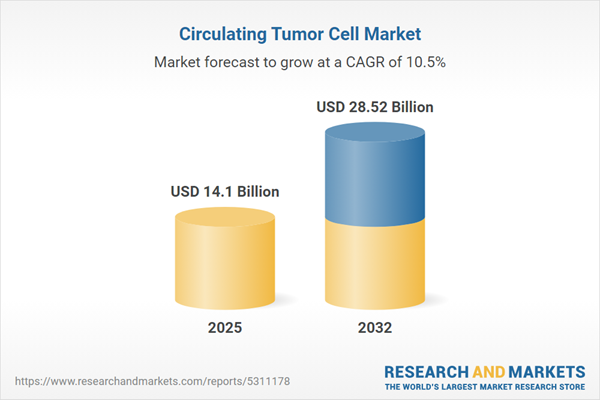Speak directly to the analyst to clarify any post sales queries you may have.
The circulating tumor cell market is rapidly evolving, forging critical pathways in cancer diagnostics, drug development, and translational research. Senior stakeholders navigating this sector must understand the latest technology shifts, supply chain dynamics, and global adoption trends to maintain competitive advantage and inform investment strategies.
Market Snapshot: Circulating Tumor Cell Market Overview
The circulating tumor cell market grew from USD 12.82 billion in 2024 to USD 14.10 billion in 2025. With a robust CAGR of 10.51%, the sector is projected to reach USD 28.52 billion by 2032. Market expansion reflects surging demand for early cancer detection, precision oncology, and scalable diagnostic solutions across key global healthcare territories.
Scope & Segmentation
- Technology Types: • CTC Analysis • CTC Detection & Isolation • Immunomagnetic Separation • Microfluidic-Based Separation
- Product Types: • Instruments • Kits & Reagents
- Applications: • Clinical Diagnostics & Research • Drug Development
- Cancer Types: • Breast Cancer • Colorectal Cancer • Lung Cancer • Prostate Cancer
- End Users: • Diagnostic Centers • Hospitals & Clinics • Research & Academic Institutes
- Geographic Regions: • Americas (United States, Canada, Mexico, Brazil, Argentina, Chile, Colombia, Peru) • Europe, Middle East & Africa (United Kingdom, Germany, France, Russia, Italy, Spain, Netherlands, Sweden, Poland, Switzerland, UAE, Saudi Arabia, Qatar, Turkey, Israel, South Africa, Nigeria, Egypt, Kenya) • Asia-Pacific (China, India, Japan, Australia, South Korea, Indonesia, Thailand, Malaysia, Singapore, Taiwan)
- Leading Companies: • Advanced Cell Diagnostics, Inc. • Bio-Techne Corporation • BioFluidica • Biolidics Limited • Creatv MicroTech, Inc. • Epic Sciences • Fluxion Biosciences, Inc. by Cell Microsystems • Greiner Bio-One International GmbH • Ikonisys, Inc. • LungLife AI, Inc. • Menarini Silicon Biosystems • Miltenyi Biotec GmbH • Precision Medicine Group, LLC • QIAGEN N.V. • Rarecells Diagnostics • ScreenCell • SRI International • STEMCELL Technologies, Inc. • Sysmex Corporation • Thermo Fisher Scientific Inc.
Key Takeaways for Senior Decision-Makers
- Circulating tumor cell technology is enabling less invasive, real-time monitoring and has emerged as a cornerstone for precision oncology workflows.
- Microfluidic and immunomagnetic separation approaches address the challenges of detecting rare, heterogeneous tumor cells and support higher capture purity and cell viability.
- Artificial intelligence tools and advanced imaging are increasingly integrated, facilitating rapid enumeration, single-cell profiling, and predictive analytics for therapeutic response.
- Clinical and research institutions face operational complexity from variability in markers, evolving assay requirements, and the need for robust, reproducible workflows.
- Platform adoption is heavily influenced by cancer-type specificity and user needs, shaping product portfolios for breast, lung, colorectal, and prostate cancers.
- Strategic collaborations between biotechnology firms, academic centers, and hospitals are accelerating technology validation and expanding market penetration.
Tariff Impact on Supply Chain and Investment
Recent United States tariff changes have imposed new duties on key laboratory instruments and reagents essential for circulating tumor cell workflows. This shift inflates sourcing costs and lengthens procurement timelines. Industry stakeholders are responding by localizing production, diversifying suppliers, and initiating joint procurement programs to contain budget pressures and sustain research momentum. As the regulatory landscape evolves, organizations that adapt by securing domestic partnerships and optimizing supply chains will mitigate risk and maintain operational continuity.
Methodology & Data Sources
This report integrates secondary research from scientific literature, regulatory filings, and technology white papers with primary insights gathered from senior executives, scientific leaders, and laboratory managers across major healthcare environments. All findings are validated through expert interviews, survey responses, and triangulation techniques to ensure accuracy and credibility.
Why This Report Matters
- Enables stakeholders to benchmark competitive positioning, assess emerging technology partnerships, and inform capital allocation decisions.
- Supports organizations in navigating regulatory shifts and complex supply chain environments specific to circulating tumor cell technology adoption.
- Delivers tailored strategic recommendations for platform investment, workflow optimization, and market entry across target cancer indications.
Conclusion
The circulating tumor cell market is positioned for sustained growth as platform innovations, robust collaborations, and practical strategies accelerate clinical translation and global adoption. Forward-looking organizations will leverage these insights to guide investment, partnership, and operational excellence in oncology research and diagnostics.
Additional Product Information:
- Purchase of this report includes 1 year online access with quarterly updates.
- This report can be updated on request. Please contact our Customer Experience team using the Ask a Question widget on our website.
Table of Contents
3. Executive Summary
4. Market Overview
7. Cumulative Impact of Artificial Intelligence 2025
Companies Mentioned
The companies profiled in this Circulating Tumor Cell market report include:- Advanced Cell Diagnostics, Inc.
- Bio-Techne Corporation
- BioFluidica
- Biolidics Limited
- Creatv MicroTech, Inc.
- Epic Sciences
- Fluxion Biosciences, Inc. by Cell Microsystems
- Greiner Bio-One International GmbH
- Ikonisys, Inc.
- LungLife AI, Inc.
- Menarini Silicon Biosystems
- Miltenyi Biotec GmbH
- Precision Medicine Group, LLC
- QIAGEN N.V.
- Rarecells Diagnostics
- ScreenCell
- SRI International
- STEMCELL Technologies, Inc.
- Sysmex Corporation
- Thermo Fisher Scientific Inc.
Table Information
| Report Attribute | Details |
|---|---|
| No. of Pages | 190 |
| Published | November 2025 |
| Forecast Period | 2025 - 2032 |
| Estimated Market Value ( USD | $ 14.1 Billion |
| Forecasted Market Value ( USD | $ 28.52 Billion |
| Compound Annual Growth Rate | 10.5% |
| Regions Covered | Global |
| No. of Companies Mentioned | 21 |









